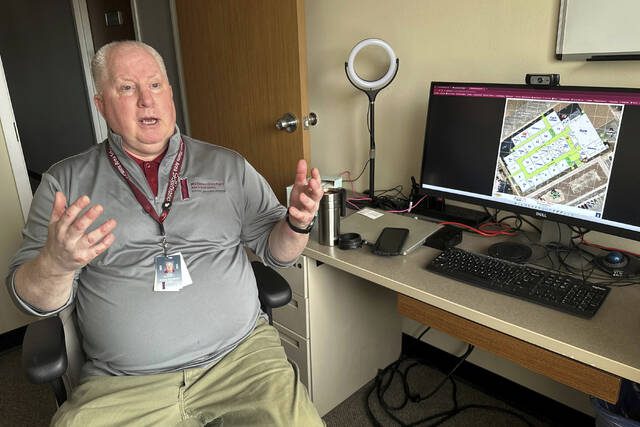When a motion sensor was triggered at Kromrey Middle School at night, a police operator pulled up a digital map of the building, located the sensor, accessed a live feed from the closest camera, and informed the police about the intruder's location.
Shortly after, they caught the culprit: a teenager wearing dark clothes and a ski mask but not carrying a weapon.
The map and cameras helped the operator prevent the situation from escalating further. The school's security director, Jim Blodgett, said, "The operator could see that it seemed like a student … just messing around in the building."
In response to mass shootings, numerous school districts have hired companies to create detailed digital maps to aid police, firefighters, and medical professionals in quicker emergency responses.
The Middleton-Cross Plains Area School District, where the teenager trespassed through a roof hatch, was an early adopter in Wisconsin. The state has since provided mapping grants to about 200 districts.
Over 20 states have introduced or suggested measures for digital school mapping in recent years. Florida approved $14 million in grants last year. Michigan allocated $12.5 million. New Jersey used $12.3 million in federal pandemic relief funds to finalize digital maps for every school in the state.
The trend has been driven by Critical Response Group, led by an Army special operations veteran. The company's CEO, Mike Rodgers, explained to lawmakers in Maryland how he used gridded digital maps during deployments and was surprised to find that his wife's school had nothing similar. He then mapped her school and expanded to 12,000 schools nationwide and is continuing to grow.
Rodgers told the AP, "When an emergency occurs at a school or place of worship, it's likely the first time those responders have been there. They are under a lot of stress and are working with unfamiliar people, similar to the military overseas, which is why this technique was developed."
Advocacy and Competition
Many state laws and bills feature nearly identical language promoted by Rodgers' company. They require confirmation through a walk-through of each campus and must be compatible with any software already used by local schools and public safety agencies. They should include aerial imagery and gridded coordinates, be oriented true north, and contain specific labeling for rooms, doors, hallways, stairwells, utility locations, hazards, key boxes, trauma kits, and automated external defibrillators.
The standards create "a competitive, fair environment" for all vendors, according to Rodgers. However, when New Jersey sought a mapping contractor, the Critical Response Group was the only company that met the legislative criteria, according to State Police mapping coordinator Lt. Brendan Liston.
The New Jersey law mandated the use of "critical incident mapping data," a term that Critical Response Group attempted to trademark.
Critical Response Group has employed lobbyists in over 20 states to push for specific standards, as per an AP review of state lobbying records. Competitors have also hired lobbyists to argue over the exact wording. In some states, lawmakers have opted for a more general label of "school mapping data."
Four companies that provide digital mapping services — Critical Response Group, Centegix, GeoComm and Navigate360 — have collectively spent over $1.4 million on lobbyists in 15 states, according to an AP analysis. In some states where lobbyist payments are not publicly disclosed, their costs remain unknown.
Delaware and Virginia also selected the Critical Response Group program. Iowa has contracted with GeoComm. Other states are leaving vendor decisions to local schools.
A response to tragedy
A U.S. Department of Justice examination of the mass shooting at Robb Elementary School in Uvalde, Texas, revealed that the police only had "a basic map" that did not display windows or doors connecting classrooms as they waited to confront the gunman.
The Texas Education Agency responded last year with new standards requiring an "accurate site layout" and door designations to be provided to 911 agencies. The Legislature strengthened this requirement by mandating silent panic buttons and armed security officers as part of a school safety initiative that costs over $1 billion.
Developing each map can incur several thousand dollars in costs, and expenses can increase as maps are integrated with other security systems, such as wearable panic buttons. However, integrations also enhance value.
“If it’s not integrated with a crisis response system that can be pushed electronically to the dispatch center and police, then it’s probably not going to mean anything to them in the first minutes,” said Jeremy Gulley, the school system superintendent of Jay County, Indiana, which uses a Centegix mapping and alert system.
Due to their detailed information, digital school maps are exempt from public disclosure under legislation in some states. This is crucial for school safety, according to Chuck Wilson, chair of the Partner Alliance for Safer Schools, a nonprofit coalition of education groups, law enforcement and security businesses.
“If bad people had access to the drawings, that would be almost worse than not knowing” a school’s layout, Wilson said. He added, “We’ve got to be really, really mindful of protecting this information.”
Maps need updating
Many schools have long provided floor plans to local emergency responders. But they haven’t always been digital. As with Uvalde, some plans have lacked important details or become outdated as schools are renovated and expanded.
Washington began digitally mapping every school in the state 20 years ago, after the deadly Columbine High School shooting in Colorado, and provided annual funding to the Washington Association of Sheriffs & Police Chiefs to operate the map repository.
However, over time, schools stopped updating the information and the maps became obsolete. The state funding proved insufficient and legislators ended the program in 2021, just as more states launched similar initiatives.
David Corr, a security advisor, managed the program and hoped it could have kept going. However, he mentioned that for emergency workers, incorrect information is more harmful than not having any information at all.



